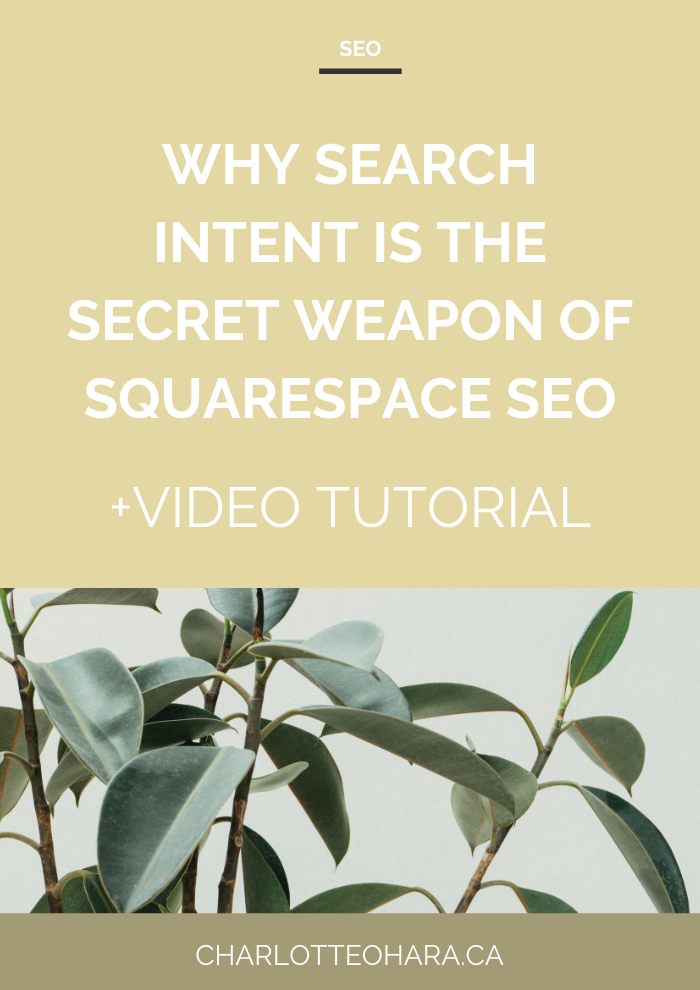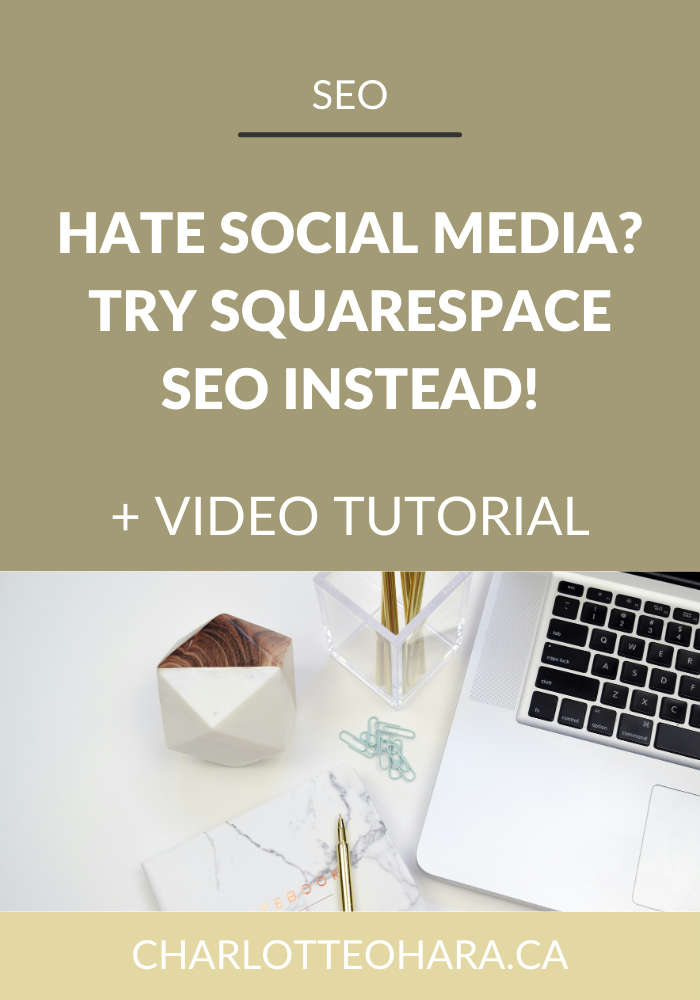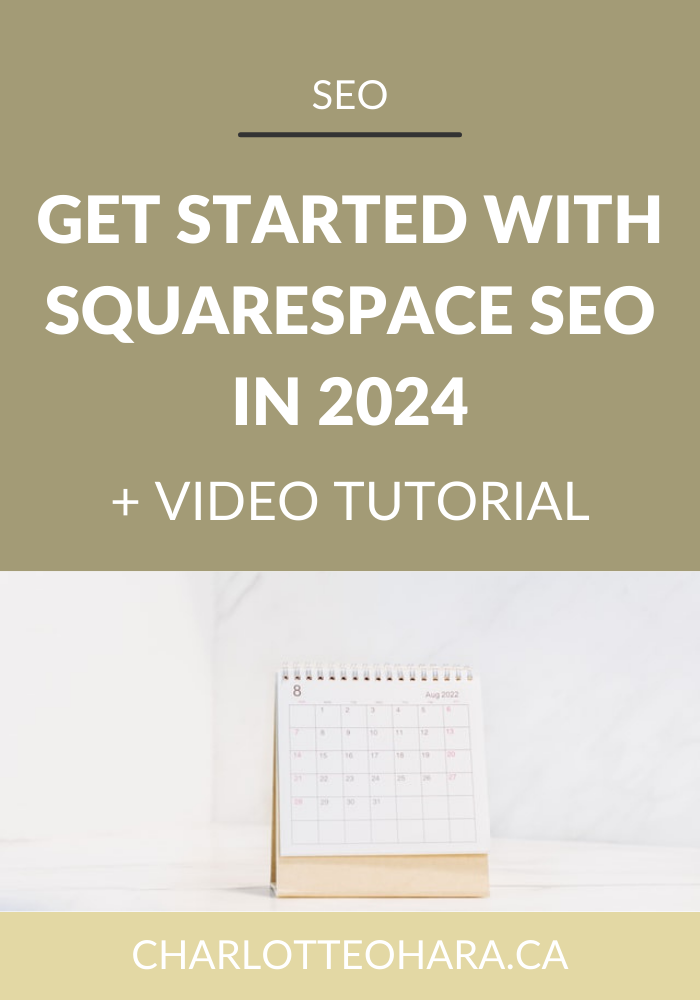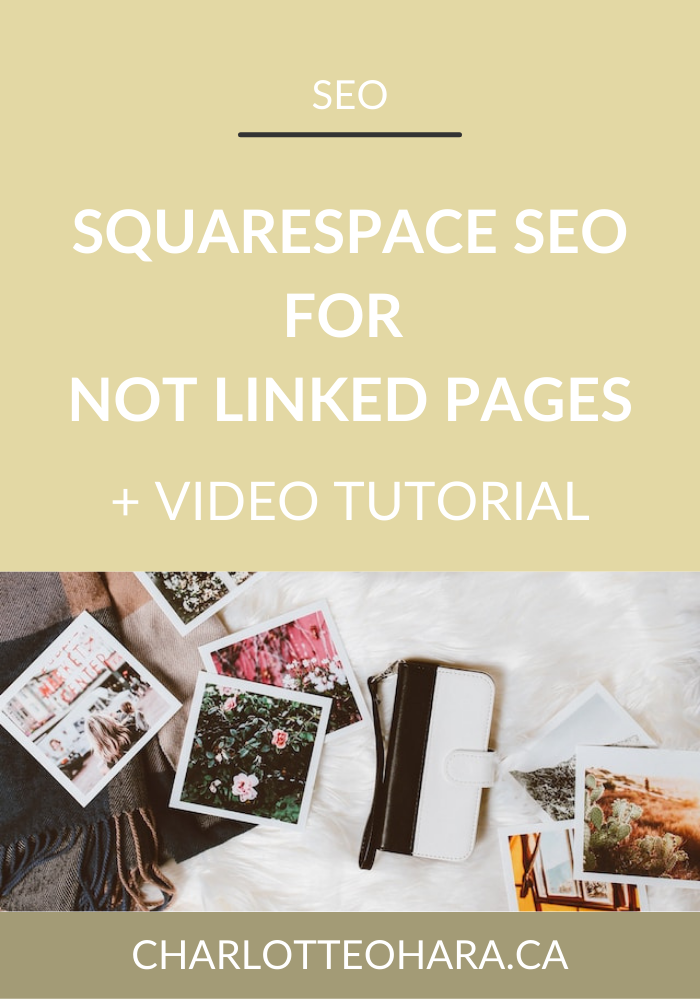Why search intent is the secret weapon of Squarespace SEO
Real talk, this might be one of the most valuable blog posts/video tutorials I’ve EVER DONE! I’m seriously pumped to share this with you because it’s a topic that I haven’t covered before but it is a seriously overlooked aspect of Squarespace SEO that you can use to your advantage.
Don’t be scared away by the term “search intent” because I promise that it’s wayyyyy more interesting than you might initially think! Trust me when I tell you that once you understand search intent, you can leverage it in a major way to drive free organic traffic to your Squarespace website - hello, first page of Google for your target keywords!
I’m also giving you the juicy goods and a behind the scenes internet peek, with loads of real life examples. This is for you if you want to look over my shoulder as I screen share and give you a first hand look at what I’m talking about!
As a Squarespace SEO expert and leader in this super random little niche, it’s my job/pleasure to introduce you to things like this and present it in a way that doesn’t make you want to flee the scene LOL!
This is the kind of insider info that I share with my Squarespace SEO consulting clients and students in my online course, Top Squarespace SEO. But since I’m not one for secrets and truly want the best for anyone with a website, I’m giving you the summarized goods here - totally for free!
Read the blog post or watch the video tutorial below - either way, search intent might just be the golden nugget you’ve been missing.
Some of you reading this might be totally new to Squarespace SEO and are looking for an introduction to this topic, someone to hold your hand and show you it’s not actually that scary. On the flip side, you might already be familiar with a few points on this list already but maybe you are looking for confirmation that you’re on the right track and haven’t missed anything important. No matter where you are in your Squarespace SEO journey, I know you’ll benefit from this info!
Alright, I know you’re positively quivering with anticipation so let’s jump right in - read the post and watch the video tutorial below to learn all about search intent and why it’s a secret weapon of Squarespace SEO!
Related:
SQUARESPACE SEO SERIES
I have so many tips to share on the subject that it would have been crazy to put it all in one article! There are many misconceptions about Squarespace SEO which is why I've dedicate so many posts to this topic. Enjoy!
Click to view all posts in the Squarespace SEO Series
Visit my Squarespace SEO page for lots more resources.
Search Intent, Squarespace SEO and ranking website content
What is search intent?
Search intent is the purpose of a user’s online search, the reason WHY they are doing this particular online search in the first place.
In my humble opinion, search intent is a criminally overlooked and under-appreciated part of Squarespace SEO so THANK GOODNESS we’re changing that with this knowledge bomb today! ;)
When you consider and understand search intent, you can use that to your advantage in order to create website pages/posts/products that rank at the top of online search results aka Google’s first page.
Search intent will guide you into creating keyword rich, targeted content that drives free organic traffic to your website - whether it’s informational for your services/offerings, an e-commerce or online shop, blog that does affiliate marketing, whatever.
Avoid the guesswork
The whole point of SEO is to get your website to show up in online search results for the RIGHT kind of online searches, that your ideal audience (aka dream clients & customers) are making.
So, if you can put yourself in their shoes and understand the WHY behind their online searches, then you can essentially work backwards to create strategic website content that tops the rankings of the keywords you’re going after.
Search intent is all about considering/understanding questions like:
What is a person looking for when they search this word/term/phrase?
What solution (if any) are they looking for?
What problem are they trying to solve?
What do they want to buy?
Most people don’t even consider this when creating website content, so if you do you’re already leagues ahead of the crowd!
4 main categories of searcher intent
*Make sure you watch the video tutorial (above) for real examples and queries/search results
There are 4 main categories of search intent:
Navigational query - searcher knows exactly where they want to go online
Informational query - searcher is looking for information or educational content
Comparison query - searcher is looking for “X vs Y product”, wants to know the difference between 2 or more options. Is close to making a purchase online but not quite ready.
Transactional or purchasing query - searcher is ready to buy online
I want you to try this out for your own website/brand/business. Think of the main keywords that you’d like to rank for and then think about the search intent behind each query. You can even run those keywords/phrases in a Google search to see what currently comes up to a real user - and where you show up in the rankings right now!
Analyze the search results & rankings
This is where the fun beings :)
Next, you’re going to analyze the search results and rankings for your target keywords to see what comes up. Is it mostly product pages? home pages? blog posts or articles?
See what’s already there and then analyze how the content that’s currently ranking satisfies search intent.
Search intent should ALWAYS guide website content strategy! There’s no point creating website content without paying attention to what people are searching for and what they’re trying to find - don’t put the horse before the carriage, ya dig?
Analyze the competition’s content
Step 1 is to understand search intent.
Step 2 is analyzing the search results & ranking.
Step 3? Creep the heck of the competition’s content - and do it better LOL!
The number one goal should be to ADD VALUE with your website content.
Jokes aside, the goal here is to see what’s currently dominating the rankings, evaluating all the strengths & weaknesses of the existing ranking content, and then coming up with a way to make your own website content that is as good as or better than the competition’s. Same same but different, if you will.
Old school SEO advice would have been to just write a lot of long blot posts if you want to rank higher, but that’s not always the answer. If you want to actually rank for your target keywords, you must understand the search intent and also evaluate what’s currently ranking.
Length
Word count is one of the most important factors in high-ranking website content. As a general rule, long-form content (which is at least 2000+ words) will rank higher in online search results than shorter pages/posts.
So, if you see that all the websites/blog posts that are currently dominating the search results for your target keyword are all at least 1000+ words, then you know you’re going to have to do at least that - if not longer! When it comes to search intent, it’s often easier to satisfy the user’s needs by creating long form content, so don’t be shy here.
Readability
If you notice that all the top ranking competitor’s content is heavy on the text but light on the headers, then this is your moment to shine! Headers are great for SEO (because they break up text and indicate hierarchy) so you should definitely be using them in your content… but headers also help to make huge pages of text easier to read! Be clear and descriptive with your headers so that if someone is scanning or skimming the page content, they can easily stop where they need to.
Readability best practices also include short paragraphs that are easy to digest, bullet points and numbered lists. You can see that I’ve included all of this in this blog post haha!
Finally, be sure to write in a way that people can actually understand what you’re talking about. Use natural language, avoid acronyms that you don’t explain, stay farrrr away from technical terms or industry jargon. When in doubt, err on the side of basic reader level - if an eight grader can’t read it easily, then it’s probably too complex. Obviously ignore this point if your target audience is niche, industry experts.
Design and UX
Believe it or not, but search intent and design/UX go hand in hand! Remember, Google wants to reward the best, highest quality & content. As such, the websites that do best in organic searches are usually user and content-centric. Meaning, they put the site visitor or reader first.
This means that the focus of the content is on value and not on direct monetization. If you create website content that follows the best design principles AND includes on-site SEO factors, then naturally you will still be able to convert, make sales, secure leads, etc.
Media
Look at the type of media that your competitor’s ranking content contains - or doesn’t have. We’re talking:
Images, graphs, graphics, charts, diagrams, tables, illustrations, etc
Audio (e.g., podcasts, recordings, etc.)
Video (e.g, demo, video tutorial, vlog, etc.)
Media could be a massive strategic advantage for you, especially if the competition isn’t maximizing this in their own content. For example, if the highest ranking content pieces each only contain one basic stock image, then you can easily do better than them by including several images, or even a video for serious SEO points. Remember, the harder or more involved the media is to produce, the fewer people/brands/businesses are going to do it - so if you do, then you are already leagues ahead and have created a unique media asset.
Identify the gaps then differentiate with your own content
Now that we know what we’re after and have creeped the heck out of the competition, it’s time to come up with a plan to differentiate your content.
Think about all the ways you can deliver VALUE to someone making an online search, thanks to your unique position. Remember that you have your own perspective, background and experience to draw on so you should always create website content that is authentic to you/your brand and never trying to front like you’re something you’re not. Be yourself, first and foremost. Write like you speak, be formal if that’s how you roll, don’t try to play it cool if you’re trying to connect with fellow nerds in a super specific niche ;)
For example, when it comes to Squarespace SEO, people CONNECT WITH MY CONTENT because I have real life experience to draw from (it’s my job, after all haha). But on top of that, they LIKE my content because I don’t take it too seriously and teach in a way that’s fun and easy to follow. Once I stopped trying to be something I wasn’t, I started getting wayyyyyy more traction and engagement with the content I put out - and this lead to a direct positive impact on my business!
Think about what people are searching for and why, then create unique content for them. Be consistent and differentiate yourself to what’s already out there.
ADD VALUE, do it as good as or better than what’s already there, differentiate yourself and you’ll be guaranteed to beat the competition.
New content vs what you already have
Search intent is super important both for the website content you already have AND for new content you plan to create.
For example, let’s say you want to rank for a specific keyword/phrase but you don’t have any website content about that already. No worries at all! This is where you do that search intent exercise, evaluation and competition sleuthing so that you can have the BEST content on that particular topic right out of the gate. It means that once you hit publish, Google will shoot you to the top of the rankings because it’s just so dang good, valuable and better than what’s already out there.
But on the flip side, maybe you’re trying to rank for a certain keyword but your existing website content just isn’t cutting it or pulling it’s weight. Don’t panic! Instead, follow the same exercises and then go back to your content and UPDATE & UPGRADE it. Wipe it clean and start from scratch if you need to, or just beef it up so that it skyrockets in value.
Final Thoughts
Search intent isn’t rocket science but once you get it, I can guarantee it’ll blow your mind with how powerful it can be!
The biggest thing to remember is that you don’t always need to reinvent the wheel if you want to create content that ranks. Instead, you just need to understand what people are looking for and then using that knowledge to create content that is as good as or better than what’s already ranking. Be better than the competition and Google will be like duh, straight to page 1 she goes.
Understanding search intent and working backwards from there is truly where the SEO golden nuggets are and I’m thrilled to be the one to share this insider info with you! :D
There’s a lot to consider with Squarespace SEO and I totally understand that it’s a daunting subject when you’re first starting out, which is why I’m thrilled to help you out with this blog post/video tutorial all about links and the role they play in Squarespace SEO!
Whether you’re just starting out with a brand new website and want to make sure that you’re setting it up correctly, or if you’ve had a site live for a while and now want to grow it to make more of an impact, SEO will get you where you want to go! From web pages to blog posts to product descriptions, these factors should be considered across your Squarespace website if you want best results.
Now it's your turn to tell me, have you ever heard about search intent? have you brainstormed any of your own target keywords and looked at what comes up? how is your content different from the competition’s? are you going to update any old content to get it to rank higher now that you understand search intent and it’s role in Squarespace SEO?
Leave me your questions down in the comments below and I’ll do my best to answer them. As people are spending more time online than ever before, it’s SO important that your website shows up properly in search results so that you can reach your ideal audience online - but you can’t do this without SEO!
If you want more SEO goodness, be sure to check out my Squarespace SEO page for all resources on the topic.
My signature online course, Top Squarespace SEO, will be opening for enrollment again soon - sign up for the TSS waiting list here!
You can also sign up for my newsletter (right here or below), where I often share Squarespace SEO tips, tricks and high-quality exclusive content. I send out emails to my list every Wednesday, mostly focused on Squarespace websites and SEO, and I can guarantee that you’ll find the newsletter topics interesting, entertaining and worth your time. #humblebrag
Finally, shameless plug: hit me up with any specific questions you have about Squarespace SEO and your website because I’m your girl. You can reach out to me directly if you’re interested in working together on your website and we can talk about whether or not you would be a good fit for my consulting and ongoing services. I can’t take on every request to do Squarespace SEO consulting but I do pick a few websites and businesses to work with every month and I’d love for you to be one of them.
You may also be interested in:
Top Squarespace SEO - online course details and enrollment
Squarespace SEO for Affiliate Marketing - masterclass













